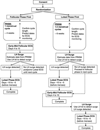The impact of menstrual cycle phase on cardiac autonomic regulation
- PMID: 19386049
- PMCID: PMC4451597
- DOI: 10.1111/j.1469-8986.2009.00811.x
The impact of menstrual cycle phase on cardiac autonomic regulation
Abstract
This study investigated menstrual cycle phase differences in heart rate (HR) and RR interval variability (RRV) in 49 healthy, premenopausal, eumenorrheic women (age 30.2+/-6.2 years). HR and RRV were computed from ambulatory 24-h electrocardiogram, collected for up to 6 days, with at least 1 day each during early to midfollicular and midluteal menstrual phases. Phase effects on HR and RRV were assessed using linear mixed effects models with a random intercept to account for the correlation of observations within each subject as well as intrasubject variation. During follicular phase monitoring, women had significantly lower average HR (-2.33 bpm), and higher standard deviation, the root mean squared successive difference, and high frequency (0.04-0.15 Hz) and low frequency (0.15-0.40 Hz) RRV than during the luteal phase. These results provide strong support for the influence of menstrual phase on cardiac autonomic regulation in premenopausal women.
Figures


Similar articles
-
The Impact of Menstrual Cycle Phases on Cardiac Autonomic Nervous System Activity: An Observational Study Considering Lifestyle (Diet, Physical Activity, and Sleep) among Female College Students.J Nutr Sci Vitaminol (Tokyo). 2017;63(4):249-255. doi: 10.3177/jnsv.63.249. J Nutr Sci Vitaminol (Tokyo). 2017. PMID: 28978872
-
Power spectral analysis of heart rate variability in healthy young women during the normal menstrual cycle.Psychosom Med. 1995 Jul-Aug;57(4):331-5. doi: 10.1097/00006842-199507000-00004. Psychosom Med. 1995. PMID: 7480562
-
Effects of menstrual cycle on cardiac autonomic innervation as assessed by heart rate variability.Ann Noninvasive Electrocardiol. 2002 Jan;7(1):60-3. doi: 10.1111/j.1542-474x.2001.tb00140.x. Ann Noninvasive Electrocardiol. 2002. PMID: 11844293 Free PMC article.
-
Impact of Menstrual Cycle on Cardiac Autonomic Function Assessed by Heart Rate Variability and Heart Rate Recovery.Med Princ Pract. 2016;25(4):374-7. doi: 10.1159/000444322. Epub 2016 Feb 1. Med Princ Pract. 2016. PMID: 26828607 Free PMC article.
-
Autonomic nervous system activity in the late luteal phase of eumenorrheic women with premenstrual symptomatology.J Psychosom Obstet Gynaecol. 2006 Sep;27(3):131-9. doi: 10.1080/01674820500490218. J Psychosom Obstet Gynaecol. 2006. PMID: 17214447
Cited by
-
Hormonal Cycles, Brain Network Connectivity, and Windows of Vulnerability to Affective Disorder.Trends Neurosci. 2018 Oct;41(10):660-676. doi: 10.1016/j.tins.2018.08.007. Epub 2018 Sep 25. Trends Neurosci. 2018. PMID: 30274602 Free PMC article. Review.
-
Effects of ovarian hormones and oral contraceptive pills on cardiac vagal withdrawal at the onset of dynamic exercise.PLoS One. 2015 Mar 18;10(3):e0119626. doi: 10.1371/journal.pone.0119626. eCollection 2015. PLoS One. 2015. PMID: 25785599 Free PMC article.
-
Sex differences in heart: from basics to clinics.Eur J Med Res. 2022 Nov 9;27(1):241. doi: 10.1186/s40001-022-00880-z. Eur J Med Res. 2022. PMID: 36352432 Free PMC article. Review.
-
The Relationship between Pain and Vascular Function Biomarkers in Dysmenorrheal University Students.Chonnam Med J. 2020 Sep;56(3):186-190. doi: 10.4068/cmj.2020.56.3.186. Epub 2020 Sep 24. Chonnam Med J. 2020. PMID: 33014757 Free PMC article.
-
Menstrual cycle hormones and oral contraceptives: a multimethod systems physiology-based review of their impact on key aspects of female physiology.J Appl Physiol (1985). 2023 Dec 1;135(6):1284-1299. doi: 10.1152/japplphysiol.00346.2023. Epub 2023 Oct 12. J Appl Physiol (1985). 2023. PMID: 37823207 Free PMC article.
References
-
- Bigger JT, Fleiss JL, Rolnitzky LM, Steinman RC. Stability over time of heart period variability in patients with previous myocardial infarction and ventricular arrhythmias. The American Journal of Cardiology. 1992;69(8):718–723. - PubMed
-
- Bigger JT, Fleiss JL, Steinman RC, Rolnitzky LM, Kleiger RE, Rottman JN. Frequency domain measures of heart period variability and mortality after myocardial infarction. Circulation. 1992;85:164–171. - PubMed
-
- Bigger JT, Jr, Fleiss JL, Steinman RC, Rolnitzky LM, Kleiger RE, Rottman JN. Correlations among time and frequency domain measures of heart period variability two weeks after acute myocardial infarction. The American Journal of Cardiology. 1992;69(9):891–898. - PubMed
-
- Chao HT, Kuo CD, Su YJ, Chuang SS, Fang YJ, Ho LT. Short-term effect of transdermal estrogen on autonomic nervous modulation in postmenopausal women. Fertility and Sterility. 2005;84(5):1477–1483. - PubMed
-
- Colditz GA, Willett WC, Stampfer MJ, Rosner B, Speizer FE, Hennekens CH. Menopause and the risk of coronary heart disease in women. The New England Journal of Medicine. 1987;316(18):1105–1110. - PubMed
Publication types
MeSH terms
Grants and funding
LinkOut - more resources
Full Text Sources

